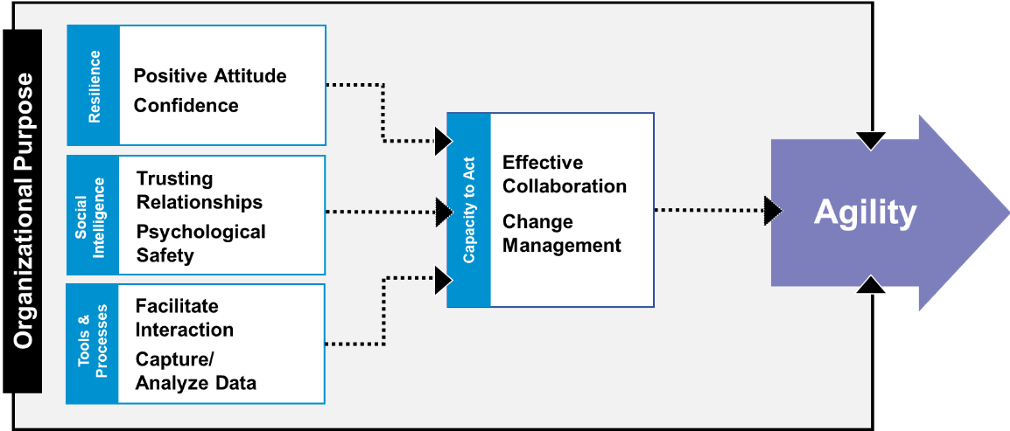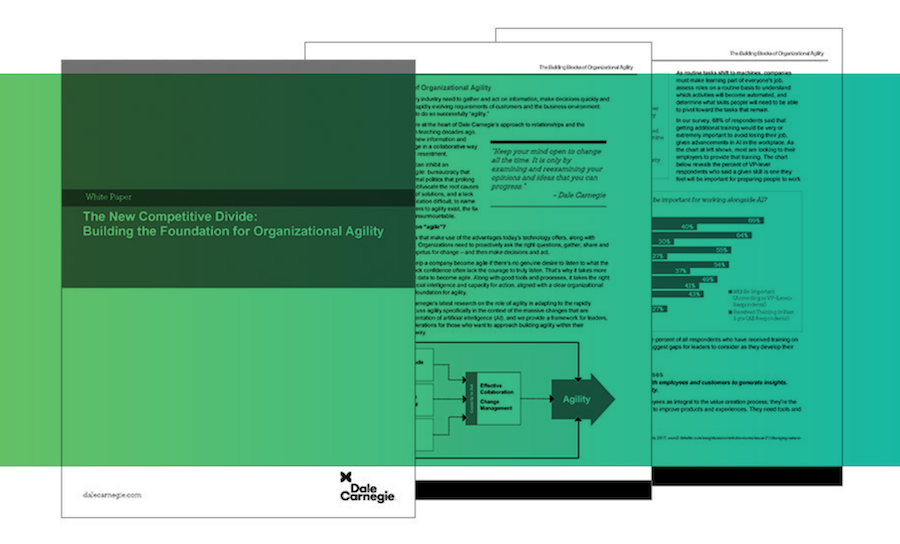Key Insights
- Agility requires the right combination of resilience, social intelligence and capacity for action, aligned with a clear organizational purpose.
- It takes more than smart people and good data to become agile—it takes people skills.
- Agility involves seeking out new information and embracing continuous change in a collaborative way.

A Model for Organizational Agility
- In a business environment marked by rapidly evolving customer requirements, heightened shareholder demands and changing employee expectations, organizational agility is critical for success.
- Agility refers to an organization’s ability to gather and act on information, make decisions quickly and implement change to meet rapidly evolving requirements of customers and the business environment.
- Along with good tools and processes, agility requires the right combination of resilience, social intelligence and capacity for action, aligned with a clear organizational purpose.
“Agile” used to be associated mostly with the tech sector, but it’s now clear that companies in every industry need to be agile. A recent study published in Forbes found that 81% of executives consider agility to be the most important characteristic of successful organizations.
That’s not surprising considering today’s business environment, which is marked by constant market disruption, rapidly evolving customer requirements, heightened shareholder demands and changing expectations of a new generation of workers. Companies need to be good at identifying and acting on new insights, making speedy decisions and implementing change.
Dale Carnegie has been exploring what makes an organization agile, particularly in the context of the tremendous changes that artificial intelligence (AI) is expected to have on the way we work. In 2019, we conducted an online, web-based survey, asking more than 3500 employees around the world (from CEOs to individual contributors, across a wide range of industries and company sizes) a number of questions about their expectations for AI and their own organization’s agility. The resulting report, “Agility: The New Competitive Divide, Preparing for Success in the Era of AI,” highlights what’s driving this need for greater agility, the common barriers to agility and the specific steps leaders can take to develop an agile organization.
Here’s a closer look at what we’ve learned about the fundamentals of agility.
What is Organizational Agility?
Agility refers to an organization’s ability to gather and act on information, make decisions quickly and implement change to meet rapidly evolving requirements of customers and the business environment.
Netflix is a good example of an agile company. First it was a mail-order DVD rental company, then a subscription DVD rental company. Then it pivoted to online delivery, and then it harnessed AI to create algorithms that know exactly what customers want, when they want it and on what device. Now Netflix is using insights from this data to enhance the customer experience and inform the production of its own original entertainment content.
AI is just one, albeit particularly powerful, way to generate insights. Agility is about responding to insights—wherever they come from—by changing what we do.
The 5 Key Elements of Organizational Agility
While some argue that the insights that come from big data are the primary reason for change these days—either to innovate or keep up with competitors—there’s more to it than that. Organizations also need to proactively ask the right questions, gather, share and analyze information, and then make decisions and act.
We also believe that no amount of data will help a company become agile if there’s no genuine desire to listen to what the data says. That’s why it takes more than smart people and good data to become agile; it takes people skills.
Based on our own experience and research, along with the work of others (including findings from Google’s Projects Oxygen and Aristotle), we’ve found that, to become truly agile, organizations need:
- A clear organizational purpose focused on creating value for the customer. Our study exploring high-performing corporate cultures confirms the importance of having a strong customer focus. In terms of agility, it provides a true north for everyone, giving people the reason for change, empowering them to advocate for changes that will make the organization more responsive and strengthening connections to customers, who can be a good source of intellectual capital. A shared goal also supports agility by breaking down functional silos and helping people work through conflict.
- Tools and processes to collect and share data and facilitate interaction among employees and with customers. Agile organizations view their customers and their employees as integral to the value creation process. As a result, they implement tools that enable easy data-collection and collaboration, and they develop processes to remove barriers to speed, productivity and innovation.
- Employee resilience, which refers to people’s ability to “bounce back” from difficult or unpleasant experiences. Since agile organizations experiment to learn, there will inevitably be missteps. Resilience requires a positive attitude and confidence, because together, these qualities will support an open mindset, one that’s primed to succeed and can quickly adjust and recover in the face of adverse situations.
- Social Intelligence, which refers to the ability to deal with challenging social contexts effectively; understanding others’ concerns, feelings and emotional states; and knowing what to say, when to say it and how to say it in order to build and maintain positive relationships with others. These skills underpin a corporate culture of psychological safety that is important for effectively supporting collaboration, creativity, innovation and change, making them critical for agility.
- The capacity to act, which refers to the organization’s ability to change in response to new information—and do it quickly. Enhancing an organization’s capacity for action involves both supporting the effective collaboration that drives innovation and effectively leading continuous change.
How Can A Business’s Organizational Agility be Improved?

There are lots of things that keep organizations from becoming agile, including bureaucracy that slows down processes, internal politics that prolong decision-making and silos that make it tough to figure out the root causes of problems and that discourage people from taking ownership of solutions. Another big barrier to agility is a lack of trust that makes communication and change difficult.
We encourage leaders to:
- Evaluate the relevance of agility to your business.
- Assess your “agility readiness.”
- Enhance the “building block” competencies for agility, beginning with leaders but ultimately involving everyone.
One big takeaway from our analysis is that the foundations for agility are right at the heart of Dale Carnegie’s approach. Agility involves seeking out new information and embracing continuous change in a collaborative way, something Carnegie captured well when he advised, “Keep your mind open to change all the time. It is only by examining and reexamining your opinions and ideas that you can progress.” An attitude like that is a great starting point for agility.

